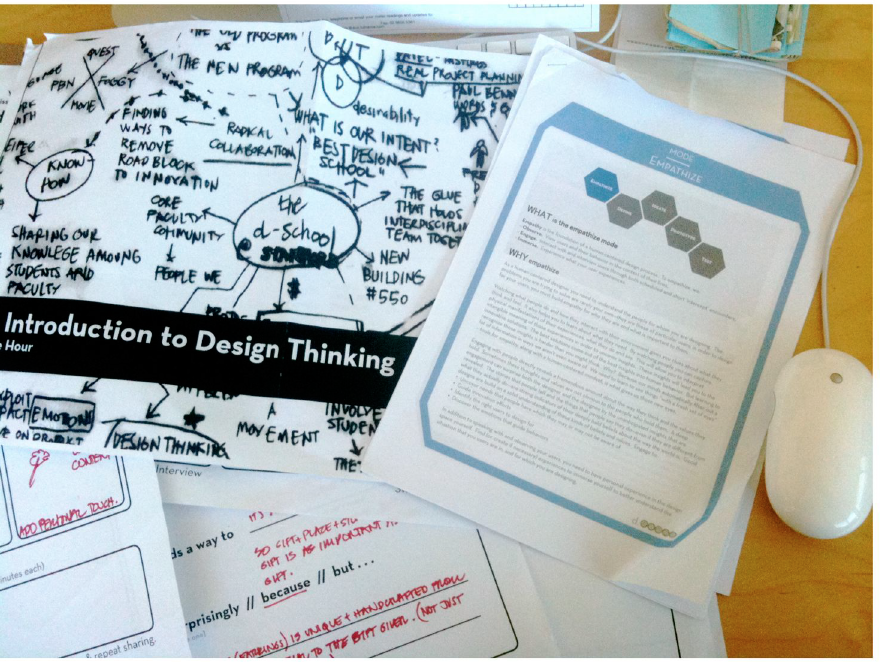
Brand + Business x Christine Moody*
‘Design Thinking’ and innovation go hand in hand. Design Thinking according to Stanford University’s d.school is a process that includes five stages or modes:
- Empathise—empathy is the centrepiece of a human-centred design process.
- Define—the mode of the design process is all about bringing clarity and focus to the design space.
- Ideate—the mode of the design process in which you concentrate on idea generation.
- Prototype—the mode is the iterative generation of artifacts intended to answer questions that get you closer to your final solution.
- Test—the mode is when you solicit feedback, about the prototypes you have created, from your users and have another opportunity to gain empathy for the people you are designing for.
I attended d.school bootcamp in 2011 as part of my Masters Degree and have continued to use the process in every part of my business and personal life. I have used this method on everything from creating new products and services for retail clients (i.e., developing Poppy Cakes’ Party in a Box), to working through my personal legal challenges, to creating a stronger and more refined, authentic personal brand (i.e., writing the first book in what will be a series of books, Designer Law School: Legal lessons for design entrepreneurs).
Whenever I get stuck on an issue, I grab my Moleskine notepad and start writing, drawing, and visually problem-solve. I also make sure that I am aware of what is happening outside my design world. I do this by reading constantly—books as well as online journals. I also make sure I hit the streets to see what is happening. For example, I find out what new retail stores are opening (both Australian and international brands) and go and visit new stores to get a feel for the brand. I also overlay these field trips with reviewing the brand’s online stores and social media.
Design thinking is action and taking action is what you have to do to truly become innovative.
As an aside, I continue to be overwhelmed by the positive feedback coming in for my book—Designer Law School. Legal lessons for design entrepreneurs. Here is another comment that I wanted to share:
All entrepreneurs have a list of things they wish they had known before starting a business. But what if you could learn them all in one place, sparing yourself endless hassle and confusion? This book lays out the steps you need to take to protect your interests and create a thriving, lucrative design practice.
Dorie Clark, author of Stand Out and Reinventing You, and adjunct professor, Duke University’s Fuqua School of Business
…………………………………………….
*Christine Moody is one of Australia’s leading brand strategists and the founder brand management consultancy, Brand Audits. With more than 30 years’ professional experience, Christine has helped a diverse client base of local and international brands, including Gold Coast City Council, Hilton Hotels, and Wrigleys USA, to develop, protect and achieve brand differentiation. Her particular interest is personal brand audits to assist executives realise their full potential. She is also an author and a law student.
For more information: chris.moody@brandaudits.com.au or +61 419 888 468.
…………………………………………….
About—Designer Law School. Legal lessons for design entrepreneurs
(Stockists Folio Books: Folio@FolioBooks.com.au; iBook store; and Amazon)
Christine Moody is one of Australia’s leading brand strategists. She is the founder of brand management consultancy, Brand Audits, and several successful start-up companies. Designer Law School is her latest venture.
This book is a cautionary tale for all designers, entrepreneurs, managers, and educators. With the wit and wisdom born of long experience (and some pretty hard knocks along the way), Christine encourages her fellow designers (and all designers, creatives, and entrepreneurs, for that matter) to respect and understand the legal issues that affect their daily business. In a series of practical ‘lessons’ full of ‘good-to-know’ tips and topics, the book alerts others to the risks of ‘doing business’ without a keen eye on the possible legal pitfalls along the way. At the same time, Christine engages the reader through her obvious care and concern for their challenges and encases her ‘lessons’ in the motivational framework of her personal struggle for justice and survival.
Photo credit: Stanford University d.school
